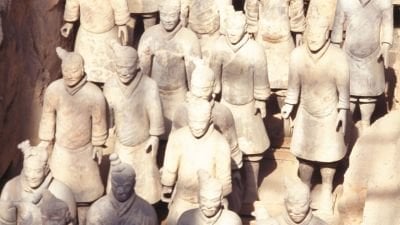
Ep 35. China's Lost Pyramids
- August 10, 2010
China's Lost Pyramids is an awe-inspiring episode from the National Geographic Documentaries season of 2010. It dives deep into the stunning and mysterious pyramids that have been buried underneath the Chinese countryside for over two thousand years.
The episode takes viewers on a journey through the rich history and culture of China, as archaeologists and historians share their fascinating findings and theories about these ancient structures.
From the air, the viewer witnesses the incredible scale and complexity of these mysterious pyramids - long stretches of grassy fields and sprawling earth mounds that seem almost otherworldly in their geometric precision and magnitude. Indeed, their perfect triangular shapes and enormous size make them some of the most significant archaeological finds in the world.
Over the course of the episode, viewers are introduced to several of these long-forgotten wonders. The first segment focuses on the fascinating story of the tomb of the Yellow Emperor - a legendary Chinese ruler said to have lived 5,000 years ago. Through extensive investigation, experts have been able to uncover a pyramid and a sprawling network of underground chambers intended to provide him with an afterlife lavish with luxury and protection.
We learn that the Yellow Emperor's tomb follows a pattern of other similar pyramids built during the early Qin Dynasty, over 2,000 years ago. And while the unique design of the structure is meant to offer a glimpse into an imagined cosmic architecture, the overall functionality of the tomb's chambers follow the belief that the emperors would take along everything they'd need with him into the next life, whether it be a thousand servants, priceless food, or treasures that would allow for the continuation of their reign.
Further, the episode explores the significant implications of these findings for our understanding of China's deep, rich history, and civilization. While scholars have long known about the pyramids of Egypt, little is known about their Chinese counterparts, which are discovered in recent research to be equally impressive architectural wonders.
One such pyramid discovered in the episode is known as the Baigong structure. The chambers found inside this pyramid are massive and geometrically connected. They are believed to be for the public performance of regular worship services, perhaps incorporating sacrifices. The Baigong core pyramid's grandiosity is enhanced by its location buried deep within an inhospitable desert region.
Lastly, the episode highlights how the study of such structures helps deepen our understanding of the spiritual and cultural traditions of ancient China. Through meticulous research, the impressive technological advancements of the Chinese people come to light, including their innovative systems of canals and intricate routes linking the tombs for the next Chinese dynasty.
In conclusion, China's Lost Pyramids is an enthralling episode from the National Geographic Documentaries series of 2010 that illuminates the grand architectural inheritance of China's buried civilization and its great emperors. It provides an excellent insight into the history and cultural values of the Chinese people through the complex and well-preserved systems and construction of the pyramids. Viewers come away from the episode with a deeper appreciation of just how much there is to learn about the secrets buried beneath the earth and how research plays a crucial role in revealing the past of those who came before us.
